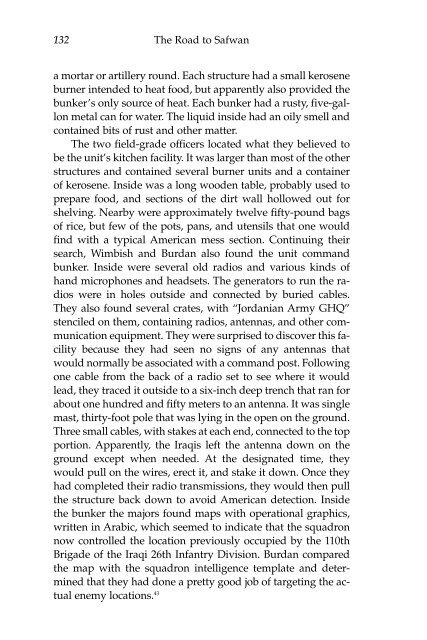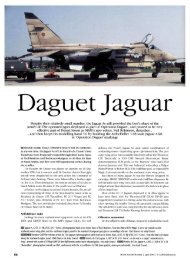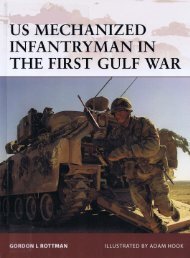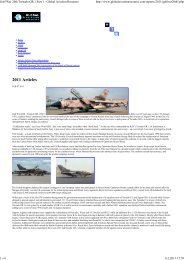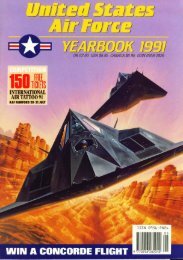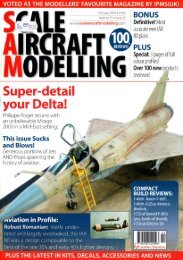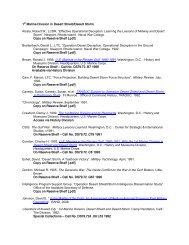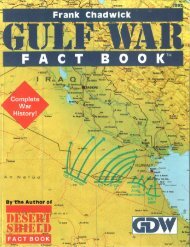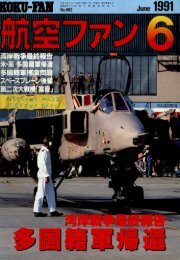The Road to Safwan: The 1st Squadron, 4th Cavalry in the 1991 ...
The Road to Safwan: The 1st Squadron, 4th Cavalry in the 1991 ...
The Road to Safwan: The 1st Squadron, 4th Cavalry in the 1991 ...
You also want an ePaper? Increase the reach of your titles
YUMPU automatically turns print PDFs into web optimized ePapers that Google loves.
132 <strong>The</strong> <strong>Road</strong> <strong>to</strong> <strong>Safwan</strong><br />
a mortar or artillery round. Each structure had a small kerosene<br />
burner <strong>in</strong>tended <strong>to</strong> heat food, but apparently also provided <strong>the</strong><br />
bunker’s only source of heat. Each bunker had a rusty, five-gallon<br />
metal can for water. <strong>The</strong> liquid <strong>in</strong>side had an oily smell and<br />
conta<strong>in</strong>ed bits of rust and o<strong>the</strong>r matter.<br />
<strong>The</strong> two field-grade officers located what <strong>the</strong>y believed <strong>to</strong><br />
be <strong>the</strong> unit’s kitchen facility. It was larger than most of <strong>the</strong> o<strong>the</strong>r<br />
structures and conta<strong>in</strong>ed several burner units and a conta<strong>in</strong>er<br />
of kerosene. Inside was a long wooden table, probably used <strong>to</strong><br />
prepare food, and sections of <strong>the</strong> dirt wall hollowed out for<br />
shelv<strong>in</strong>g. Nearby were approximately twelve fifty-pound bags<br />
of rice, but few of <strong>the</strong> pots, pans, and utensils that one would<br />
f<strong>in</strong>d with a typical American mess section. Cont<strong>in</strong>u<strong>in</strong>g <strong>the</strong>ir<br />
search, Wimbish and Burdan also found <strong>the</strong> unit command<br />
bunker. Inside were several old radios and various k<strong>in</strong>ds of<br />
hand microphones and headsets. <strong>The</strong> genera<strong>to</strong>rs <strong>to</strong> run <strong>the</strong> radios<br />
were <strong>in</strong> holes outside and connected by buried cables.<br />
<strong>The</strong>y also found several crates, with “Jordanian Army GHQ”<br />
stenciled on <strong>the</strong>m, conta<strong>in</strong><strong>in</strong>g radios, antennas, and o<strong>the</strong>r communication<br />
equipment. <strong>The</strong>y were surprised <strong>to</strong> discover this facility<br />
because <strong>the</strong>y had seen no signs of any antennas that<br />
would normally be associated with a command post. Follow<strong>in</strong>g<br />
one cable from <strong>the</strong> back of a radio set <strong>to</strong> see where it would<br />
lead, <strong>the</strong>y traced it outside <strong>to</strong> a six-<strong>in</strong>ch deep trench that ran for<br />
about one hundred and fifty meters <strong>to</strong> an antenna. It was s<strong>in</strong>gle<br />
mast, thirty-foot pole that was ly<strong>in</strong>g <strong>in</strong> <strong>the</strong> open on <strong>the</strong> ground.<br />
Three small cables, with stakes at each end, connected <strong>to</strong> <strong>the</strong> <strong>to</strong>p<br />
portion. Apparently, <strong>the</strong> Iraqis left <strong>the</strong> antenna down on <strong>the</strong><br />
ground except when needed. At <strong>the</strong> designated time, <strong>the</strong>y<br />
would pull on <strong>the</strong> wires, erect it, and stake it down. Once <strong>the</strong>y<br />
had completed <strong>the</strong>ir radio transmissions, <strong>the</strong>y would <strong>the</strong>n pull<br />
<strong>the</strong> structure back down <strong>to</strong> avoid American detection. Inside<br />
<strong>the</strong> bunker <strong>the</strong> majors found maps with operational graphics,<br />
written <strong>in</strong> Arabic, which seemed <strong>to</strong> <strong>in</strong>dicate that <strong>the</strong> squadron<br />
now controlled <strong>the</strong> location previously occupied by <strong>the</strong> 110th<br />
Brigade of <strong>the</strong> Iraqi 26th Infantry Division. Burdan compared<br />
<strong>the</strong> map with <strong>the</strong> squadron <strong>in</strong>telligence template and determ<strong>in</strong>ed<br />
that <strong>the</strong>y had done a pretty good job of target<strong>in</strong>g <strong>the</strong> actual<br />
enemy locations. 43


